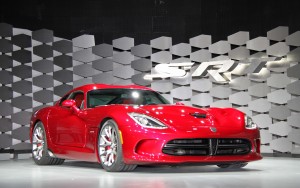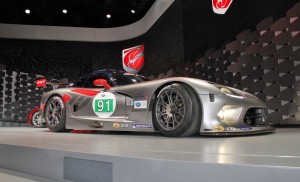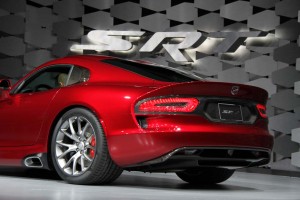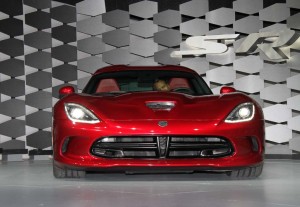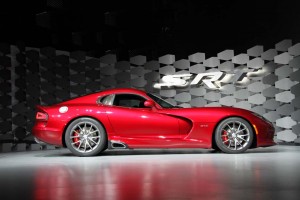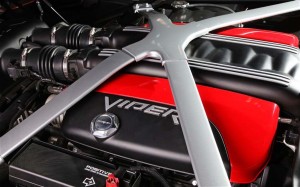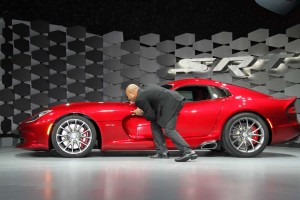
SRT chief Ralph Gilles - also Chrysler's corporate design chief, plants a welcome kiss on the new SRT Viper.
It’s the rare automaker that can keep secrets, but Chrysler pulled off a coup by keeping the covers on the reborn Dodge Viper up until the very moment the 2-seat supercar made its debut at the opening press day of the 2012 New York Auto Show.
Make that the SRT Viper, because the 2013 model will wear the badge of Chrysler’s Street Racing Team division when it returns to showrooms this year. And it will live up to the full meaning of that name. With its 640-horsepower V-10, Chrysler expects the 2013 Viper to dominate on both the street and the track, with the new model set to enter the American Le Mans Series.
The launch of the snake is clearly one of the highlights of this year’s show, an overflow crowd struggling to get a look at the long-nosed sports car. All but jumping for joy, Ralph Gilles, Chrysler’s chief corporate designer and the head of the SRT division, recalled the improbable story of the fight to revive the Viper – which former owners Cerberus tried to sell in the months leading up to the maker’s 2009 bankruptcy.
“It’s huge that we’re here today,” proclaimed Gilles. “It’s like being pregnant for 24 months.”
Those familiar with the outgoing Viper won’t be taken by surprise. The basic shape and dimensions are in keeping with the car’s heritage look, albeit with decidedly more contemporary details. There’s the incredibly long snout designed to house the new car’s upgraded V-10, the short rear overhang and the curvaceous roof that flows into an integrated rear spoiler.
The original, 1992 Dodge Viper was hailed by Chrysler as the rebirth of the classic American sports car, and Gilles emphasized that the 2013 SRT Viper has been “designed in Auburn Hills (Michigan) by Americans and will be built in Detroit.” Well, yes, but he also quickly acknowledged that his team “did consult with our friends at Ferrari/Maserati,” the high-performance arm of Chrysler’s Italian partner, Fiat.
Pride is likely to lead many parents to claim credit for fathering the new Viper but sorting through the noise it is apparent that those Fiat brands provided much of the essential work on Viper’s underlying platform, though the suburban Detroit folks did the dominant work on powertrain and exterior design.
The Italians, meanwhile, were critical to shifting the shape of Viper’s traditionally plebian interior into something much more world-class. “They’re masters of low-volume products (and) had the ability to give Viper the extra magic (inside that) it never had.”
There’s been plenty of speculation about how Gilles’ team would handle exterior styling. Some had hoped to see Viper head off in an entirely new direction. But in a recent interview with TheDetroitBureau.com, the executive said it was clear the new car would need to honor its “heritage,” without becoming retro.
One way the Viper has shifted gears is in the new 2-seater’s extensive use of state-of-the-art technology. The original car was the only vehicle in the Chrysler corporate fleet, at the time, without airbags and didn’t even have antilock brakes.
These days, federal rules require both airbags and brake intervention technologies such as ABS, traction control and electronic stability control. After plenty of soul-searching – and consulting with influential Viper fans and owners – the decision was made to add such niceties as cruise control, and even an electronically adaptable suspension.
The good news for Viper purists is that much of that technology can easily be disabled. There’s a four-stage stability control system that includes full-off mode.
But one thing even traditionalists are likely to enjoy is the warning system intended to remind you to shift. “Most cars have a shift light,” said Gilles. “We have a shift snake,” a large, bright red Viper logo that lights up in the center of the instrument panel.
What will thrill both groups is the basic Viper powertrain, an 8.4-liter V-10 making 640 horsepower – 40 more than the last of the old snakes – and 560 lb-ft of torque, a 40 lb-ft increase. It feeds the rear wheels through a six-speed manual transmission.
As big a boost as the new engine delivers that understates the real impact. The 2013 SRT Viper makes extensive use of high-strength steel and aluminum. That not only yields a much stiffer body and chassis but a car that weighs in 100 pounds under the old model, at 3,354 pounds. On a dry weight basis, it has more horsepower per pound than all but the Bugatti Veyron and the new Ferrari F12.
SRT will offer two versions of the 2013 sports car, what Gilles describes as the “more flamboyant” SRT Viper, with a dedicated hood design, and the more premium SRT Viper GTS.
Meanwhile, the company promises to offer an extensive catalogue of options, including a wide range of interior and exterior colors. Based on previous versions, SRT will likely add a huge list of body panel and engine upgrades.
The decision to revive the Viper wasn’t easy. But it began to take shape after Sergio Marchionne took over as Chrysler CEO in 2009. He effectively argued that sometimes it’s important to have a product line that isn’t purely about profit.
Viper “will make a little money,” Gilles echoed from the Dodge stand at the NY Auto Show, “but it’s going to be have a big impact on the bottom line.” The decision to bring the sports car back, instead, “shows we have a soul as a car company.”
The new 2013 SRT Viper will be produced at the Conner Avenue Assembly Plant, in Detroit – a factory that was closed after Chrysler’s bankruptcy but is being opened specifically to produce the snake.

